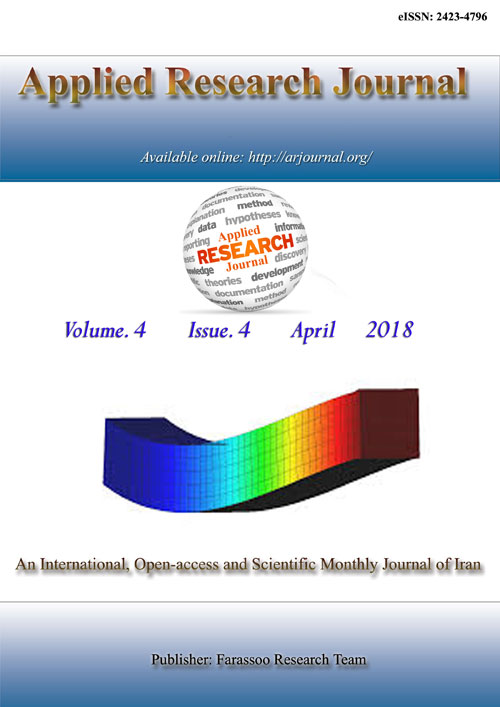فهرست مطالب

Applied Research Journal
Volume:1 Issue: 8, oct 2015
- تاریخ انتشار: 1394/08/15
- تعداد عناوین: 4
-
Pages 422-432The surface quality of a pavement determines to a large degree the conditions under which safety can be maintained. Driver control of vehicles is strongly dependent upon pavement surface characteristics. Important surface characteristics include pavement micro texture, macro texture, and drainage attributes. The pavement surface texture should provide adequate levels of friction and ride quality and maintain low levels of noise and roughness. Many transportation departments perform routine skid resistant testing, the type of equipment used for testing varies depending on the preference of each transportation department. It was felt that modeling of the surface texture condition using different methods of testing may assist in solving such problem. In this work, macro texture and micro texture of cement concrete and asphalt concrete pavement surface have been investigated in the field using four different methods (The Sand Patch Method, Outflow Time Method, British Pendulum Tester and Photogrammetry Technique). Two different grain sizes of sand have been utilized in conducting the Sand Patch, while the micro texture was investigated using the British Pendulum tester method at wet pavement surface conditions. The skid number SN was determined based on test results of the four methods. The test results were correlated to each other in terms of the skid number. It was concluded that such modeling could provide instant data in the field for pavement condition which may help in pavement maintenance management.Keywords: Macro, texture, micro, texture, skid resistance, sand patch, outflow time, modelling, Pavement
-
Pages 433-436Phytochemical and physicochemical analysis of extracts of air dried and fresh samples of vernonia amygdalina leaves obtained from Jere local gov’t area of Borno State was carried using smart spectrophotometer and other standard methods. The phytochemical screening revealed the presence of flavonoids, alkaloids, terpenoids, saponins, tannins and cardiac glycosides. Carbohydrate was found to be absent in the general test, so also for monosaccharides, free reducing sugar, combined reducing sugar and pentoses, only ketose was present in this family. The elemental contents analysed in the samples are sodium; dry (74.0 mg/l) and fresh (96.0 mg/l), Zinc; dry (0.35mg/l) and fresh (0.22 mg/l), Calcium; dry (1.12 mg/l) and fresh (2.15 mg/l), Nickel; dry (0.35 mg/l) and fresh (0.21 mg/l), Manganese; dry (0.02 mg/l) and fresh (0.03mg/l). The samples were also analyzed for some of their physical properties such pH; [dry- (10.10)] and [fresh- (12.70)], conductivity; [dry- (3.84 µs/Cm) and fresh- (6.21 µs/Cm)], Turbidity; [dry (58 FTU) and fresh (10 FTU)] and color; [dry (68.40 Cu) and fresh- (72.0 Cu)]. In view of these results obtained, it may be concluded that V. amygdalina has medicinal potential and also contained the essential elements estimated in remarkable concentration, and hence can be consumed as food or food supplement.Keywords: Macro, texture, micro, texture, skid resistance, sand patch, outflow time, modelling, Pavement
-
Pages 437-443Experimental test results were presented in this paper from a series of consolidation tests for clay soil and/or clay soil mixed with fine sand content of (0, 10, 20, 30, 40, 50, 60 and 80%).. The fine sand content, at which the intergranular void ratio of the clay-fine sand mixture became equal to emax of plain soil, was named as Transition Fine Sand Content (TFSC), occurred at (55-70)% fine sand content. Tests showed that, up to TFSC, compression behavior of the mixture is mainly controlled by clay soil. When concentration of fine sand content exceeds TFSC the fine sand control the behavior. Compression index Cc, swelling index Cs, coefficient of volume compressibility mv, swelling pressure and swelling potential decrease as the fine sand content increase.Keywords: Clay, Sand mixture, Transition content, Compression Behaviour, Intergranular Void Ratio
-
Pages 444-450In this paper the relation between the total dissolved salts (TDS) and the hydrometer test results is found by using the statistical analysis program (SPSS). To find this relation, a real data are used which represent the results of the hydrometer test and the corresponding results of the total dissolved salts test taken from tests done on Iraqi soils. A new equation is found from this relation. By using this equation the total dissolved salts (TDS) could be found easily without need to apply the ordinary usual long test.The proposed equation is presented with a proposed procedure and by applying this equation the one could provide the time needed for testing the total dissolved salts (TDS) which last for three day. Or will at least give a preliminary value of salts ratio and reduce the numbers of tests needed.This equation gives a very good result where the correlation factor equal to (0.965) and the root square equal to (0.932).Keywords: Hydrometer, Final Reading, Total Dissolved Salts, Statistical Relation, preliminary


